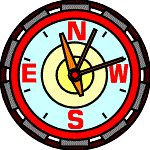MAGNETISM AND THE COMPASS

SHORT TERM GOALS:
- To help students become familiar with the compass and its
importance on travel.
- To help students make connections between compass directions
and the magnetic field that surrounds the earth.
TIME ALLOTMENT: 1 hour
CONTENT AREAS ADDRESSED:
- Science
- Geography
- Language Arts
CONCEPTS ADDRESSED:
- Magnetism
- Direction
- Travel
MATERIALS:
- Paper and Pencil
- Needle
- Bar Magnet
- Small Dish or a Large Cap of Some Sort
- Cork
PROCEDURE:
The earth has a thick iron and nickel core, which is constantly
convecting. This movement has caused our planet to develop a
magnetosphere that extends into space-thus making our Earth similar
to a huge magnet. The center of this magnet, the core of the earth
allows travelers to use a compass for navigation and directional
purposes. This magnet that surrounds the earth does not point exactly
north, but slightly off course. However it is not enough that
travelers cannot understand the direction.
In past times, travelers depended mainly on the compass to direct
them on course. If the compass broke or failed in some way, the
travelers could be lost out to sea. This activity will help students
understand the concept of magnetism and the compass. The compasses
will not fail, but rather, the students will be able to understand
the importance of the compass. The students will then connect these
ideas to the idea of being lost at sea, in case the compass did fail
for some reason.
- The students can make a model of the earth, either on paper,
or any other way they wish, making sure to note the north and
south poles. They can also make sure to have a bar magnet oriented
north-south.
- After placing the bar magnet on the earth, the students can
now make their compass, which they can place onto their ships or
use for other purposes.
- Rub a needle on the bar magnet, which will attract the needle
to the magnet. Push the needle through a small cork and float it
in a small dish.
- Observe the needle, in relation to the magnet on the model
earth, as it is placed around the magnet in each direction of
north, south, east, and west.
- Because this activity is only a modified example of what a
compass can do, allow the students to research other experiment
books or books on magnetism. The students may come up with their
own activity, which they can share with the class at a later date.
Possible experiment books can be found in the reference section of
the lesson, but the Internet or other books can also be used.
ASSESSMENT:
- Experiment Rubric
- Observation Checklist
EXTENSIONS:
- Study more about magnetic fields by making a model magnetic
field.
- Investigate compass directions by discussing the degrees, what
directions are found at specific degrees, and other angles.
--Azimuth
--Declination
- Compare compass directions to celestial observations and how
stars can work like a compass.
RESOURCES:
http://www.exploratorium.edu/xref/exhibits/circles_of_magnetism_i.html
Challand, H.J. (1984). Activities in the physical sciences.
Chicago: Childrens Press. [ISBN: 0-516-00504-9]
Elementary science experiments. (1971). Compton, CA:
Educational Insights. [ISBN: 0-88679-352-1]
Go to:
Exploring the Disappearances of the
Bermuda Triangle lesson
Current Direction lesson
Table of Contents
St. Norbert College Ocean
Voyager's page

